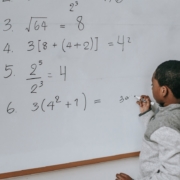Understanding Division Printable Lesson Plan
Lesson Title:Understanding Division
Lesson Objective: Students will be able to understand and use division in mathematical operations.
Materials: Whiteboard, dry erase markers, worksheets with division problems, a set of manipulatives (e.g. base ten blocks, Cuisenaire rods)
Introduction (5 minutes): Start the lesson by asking students if they know what division is. Write the symbol “÷” on the whiteboard and ask students to provide examples of what division might be (e.g. 20 ÷ 4, 12 ÷ 3, etc.).
Direct Instruction (20 minutes): Explain to students that division is a mathematical operation used to find the number of times one number is contained in another. Write the equation “20 ÷ 4” on the board and ask students what the answer is. (Answer: 5) Use base ten blocks or other manipulatives to model the problem and help students visualize the concept of division.
Next, explain the concept of remainders in division. Write the equation “10 ÷ 3” on the board and ask students what the answer is. (Answer: 3 with a remainder of 1)Guided Practice (25 minutes): Provide students with worksheets containing division problems, including some with remainders. Have students work in pairs to solve the problems, and circulate around the room to provide assistance as needed.
Independent Practice (15 minutes): Give students additional problems to work on independently. Encourage them to use the skills they have learned to solve the problems and use the manipulatives when necessary.
Closure (5 minutes): Ask students to share one thing they learned about division during the lesson. Review key concepts and remind students that division is a mathematical operation used to find the number of times one number is contained in another, and that remainders can also be a part of the solution.
Assessment: Observe students during independent practice and provide feedback on their understanding of division. Collect and grade their worksheets to check their understanding.
Note: The lesson could be adapted to include the relationship between division and multiplication, and how we can use one operation to find the solution to the other.










